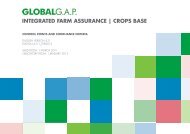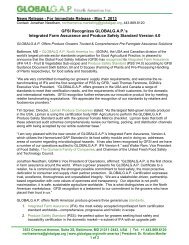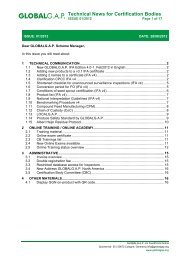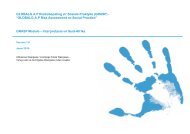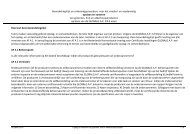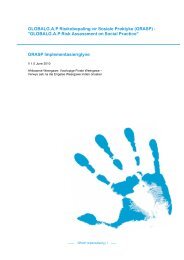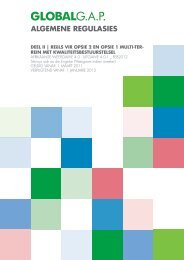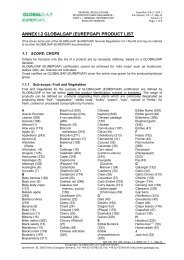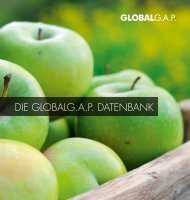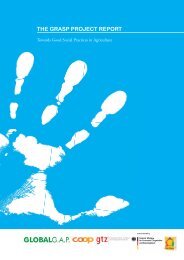CPCC Transport - GLOBALG.AP - GlobalGAP
CPCC Transport - GLOBALG.AP - GlobalGAP
CPCC Transport - GLOBALG.AP - GlobalGAP
You also want an ePaper? Increase the reach of your titles
YUMPU automatically turns print PDFs into web optimized ePapers that Google loves.
111004_gg_cpcc_transport_eng_final_version_1_Oct11<br />
ANNEX 3 FITNESS FOR TRANSPORT<br />
Control Points and Compliance Criteria<br />
<strong>Transport</strong><br />
ENGLISH VERSION<br />
3.1 No animal shall be transported unless it is fit for the intended journey, and all animals shall be transported in conditions guaranteed not to cause them injury or<br />
unnecessary suffering.<br />
3.2 Animals that are injured or that present physiological weaknesses or pathological processes shall not be considered fit for transport and in particular if:<br />
(a) they are unable to move independently without pain or to walk unassisted;<br />
(b) they present a severe open wound, or prolapse;<br />
(c) they are pregnant females for whom 90 % or more of the expected gestation period has already passed, or females who have given birth in the previous<br />
week;<br />
(d) they are new-born mammals in which the navel has not completely healed;<br />
(e) they are pigs of less than three weeks, lambs of less than one week and calves of less than ten days of age, unless they are transported less than 100 km;<br />
3.3 However, sick or injured animals may be considered fit for transport if they are:<br />
(a) slightly injured or ill and transport would not cause additional suffering; in cases of doubt, veterinary advice shall be sought;<br />
(b) transported under veterinary supervision for or following veterinary treatment or diagnosis. However, such transport shall be permitted only where no<br />
unnecessary suffering or ill treatment is caused to the animals concerned;<br />
(c) animals that have been submitted to veterinary procedures in relation to farming practices such as dehorning or castration, provided that wounds have<br />
completely healed.<br />
3.4 When animals fall ill or are injured during transport, they shall be separated from the others and receive first-aid treatment as soon as possible. They shall be<br />
given appropriate veterinary treatment and if necessary undergo emergency slaughter or killing in a way which does not cause them any unnecessary suffering.<br />
3.5 Sedatives shall not be used on animals to be transported unless strictly necessary to ensure the welfare of the animals and shall only be used under veterinary<br />
supervision.<br />
3.6 Lactating females of bovine, ovine and caprine species not accompanied by their offspring shall be milked at intervals of not more than 12 hours.<br />
© Copyright: <strong>GLOBALG</strong>.A.P. c/o FoodPLUS GmbH,<br />
Spichernstr. 55, 50672 Köln (Cologne) Germany | Tel: +49-221-57993-25; Fax: +49-221-57993-89 |<br />
http://www.globalgap.org<br />
Code Ref: LT 1.0 –<strong>CPCC</strong><br />
Version: V1.0_Oct11<br />
Page: 14 of 31



